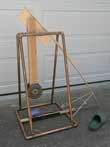
Home | Types | Construction | Project | Launch Ops/Tuning/Debug | Combat | Contact Me
All trebuchets have:
When the counterweight drops the sling and the missile it contains are dragged down the guiding trough, whipped up into the air, and swung in an arc above the trebuchet frame. At a critical point one end of the sling slips off of a peg at the end of the throwing arm; if the sling length has been adjusted so that the missile is travelling at a 45 degree angle at that instant, the maximum distance can be achieved.
Trebuchets can be placed into four different categories:
The object of most of these designs (the fixed counterweight/fixed frame is the exception) is to allow the counterweight to fall as close to vertically as possible from the cocked
position, thus imparting the most energy to the projectile and the least energy back into the trebuchet framework, which can subject the machine to damaging lateral forces.
The swinging counterweight trubuchet is the classic design where the frame is fixed to the earth and the counterweight consists of a basket
of rocks and earth hanging from one end of the throwing arm. The basket allows the weight to fall more vertically than if it were fixed since the basket is free to swing and will adjust its fall, to a degree. Here is a link to this design: Swinging Counterweight Trebuchet Some designs have proportionately long basket handles, and have a smoother post-launch action because of it.
The large trebuchet that Hugh Kennedy built is a fixed counterweight design with the frame securely fastened to the earth. This is the simplist design in terms of the number of parts, and it can hurl large objects, but it is not as efficient as other trebuchet designs. This design forces the counterweight to fall in a semi-circular arc rather than to allow the weight to fall vertically, and robs the system of some of its power - trebuchets of different design that are of the same scale can throw the same objects farther. Moreover, significant lateral forces are transmitted to the frame during a launch so the frame must be built very sturdily and anchored securely.
The fixed counterweight trubuchet with a floating frame (i.e., the frame is mounted on wheels and the entire system is free to surge to and fro when the trebuchet is fired) was a lost design rediscovered by Wayne Neel, an engineer at Virginia Military Institute (VMI), when he closely inspected images from the Middle Ages and discovered that some trebuchet frames had wheels on them. He built some model trebuchets and tested them with and without the wheels, and found the difference in behavior was remarkable: with the wheels the frame could surge back and forth by a small amount, allowing the counterweight to fall more vertically. Lateral forces were simply accomodated rather than resisted by the framework. Moreover, the missile was thrown thirty percent farther when the wheels were employed than when they weren't! See the image above of a trebuchet I built based on this design.
In this design the counterweight is constrained by a track to fall dead vertical, and the entire throwing arm, running on wheels set in a horizontal track, shifts to accomodate the counterweight. See this page for for images: FAT Trebuchet Model.
This design appeared in the late twentieth century. Many sources assert that this is the most efficient design of the four trebuchet types listed above. Here is a quotation from W. E. Jahsman (FAT Analysis):
By introducing clever modifications to the conventional trebuchet design, R. Toms (Ref. 1) has been able to increase both range efficiency and range of this medieval siege machine.
Using the wheeled frame concept introduced by W. Neel to minimize machine pitch (Ref. 2) as a starting point, Toms developed a machine which allows the axle to translate along a horizontal track (floating arm trebuchet or FAT) while constraining the counterweight to fall vertically during launch.
After several experimental iterations, he was able to demonstrate a machine of exceptional range efficiency (above 70%) and throwing power (range of almost 50 sling lever arm lengths).
Jahsman goes on to back up this assertion with trigonometry and differential calculus.
Here is a link to this design: Floating Arm Trebuchet (FAT)